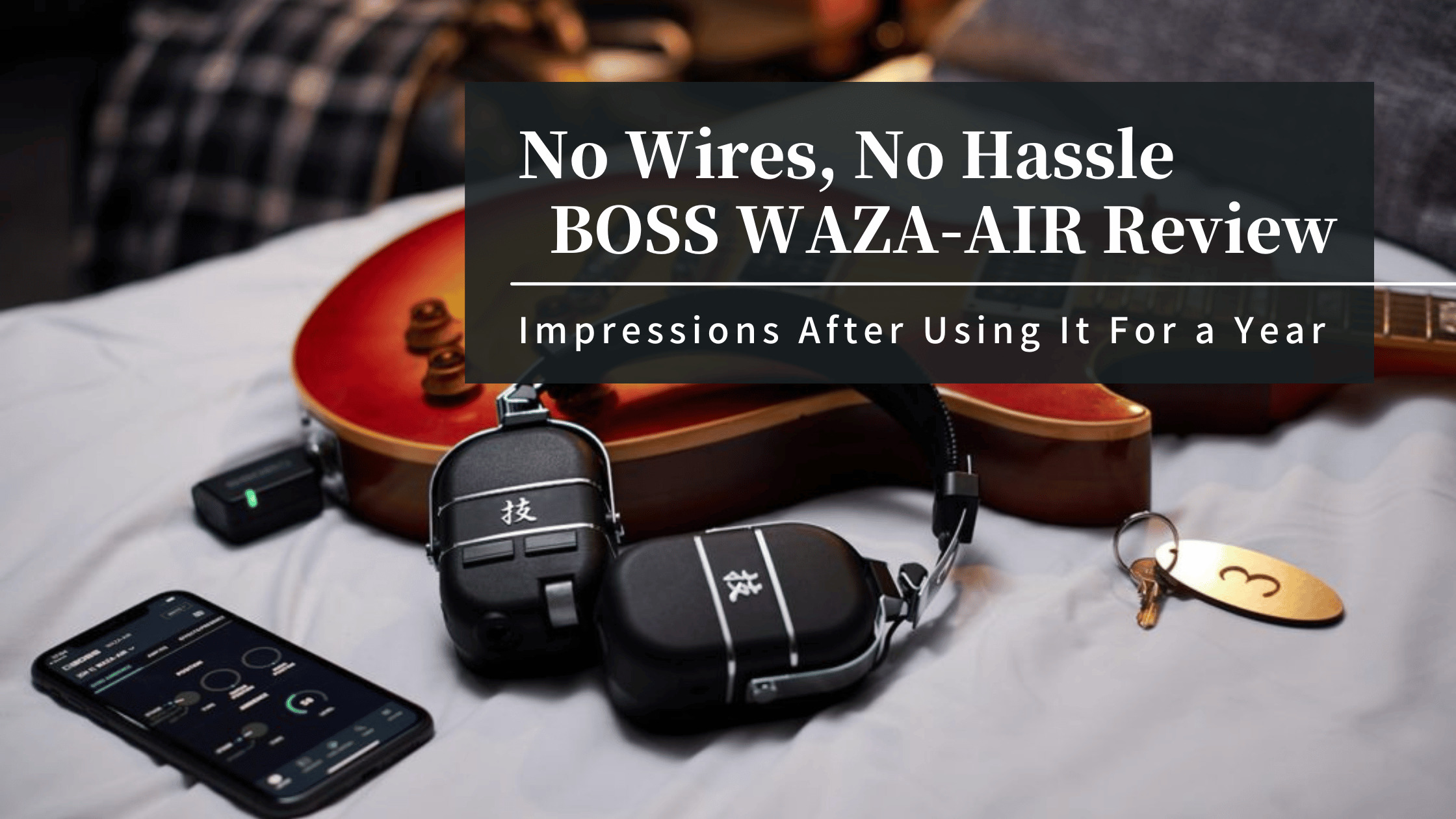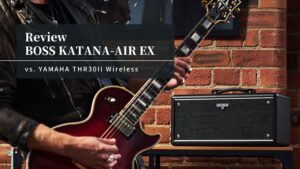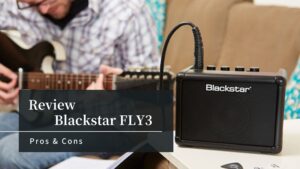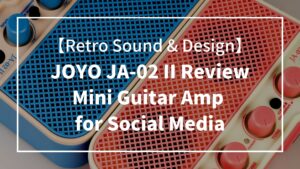The BOSS WAZA-AIR, after a year of use, offers ultra-low latency, high-quality amp and effects, easy operation, a strong headphone hold, and compact storage. However, it has some drawbacks like typical BOSS sound quality, an unnecessary gyro sensor for me, and occasional connection issues. Despite these cons, its wireless headphone feature makes it an excellent tool for home guitar practice, increasing playing time and overall satisfaction.
If you are those who:
● Want to play the guitar with wireless headphone.
● Want to play the guitar immediately for practice.
● Want the feeling of playing an amp despite headphones.
This thorough review of BOSS WAZA-AIR by an ex-music store clerk Yosh (@Yosh_Guitar) is for you. I review the Pros and Cons, additionally, I share my thoughts after using the BOSS WAZA-AIR for a year. I hope this can be a reference for those considering purchasing it.
Pros of BOSS WAZA-AIR
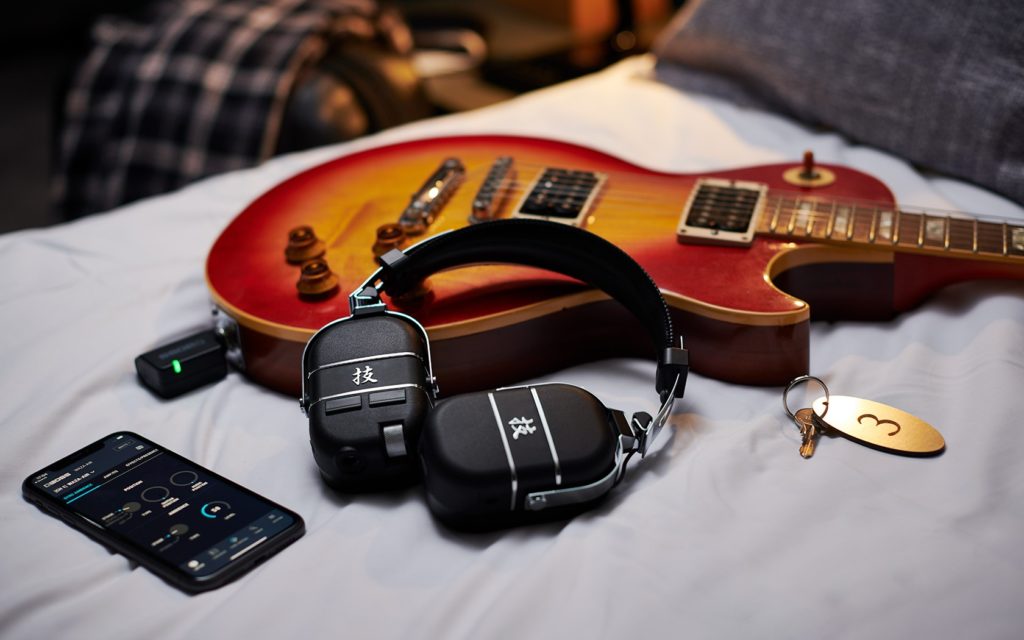
- Only One Ultra-Low Latency Wireless Headphone for Guitar
- High-Quality Amp and Effects
- Selectable Playing Environment with Gyro Sensor
- Audio Playback and Sound Creation via Bluetooth App
- Easy Operation with Just the Main Unit (Volume/Patch)
- Excellent Hold of the Headphones
- Compact Storage
Pro 1: Only One Ultra-Low Latency Wireless Headphone for Guitar
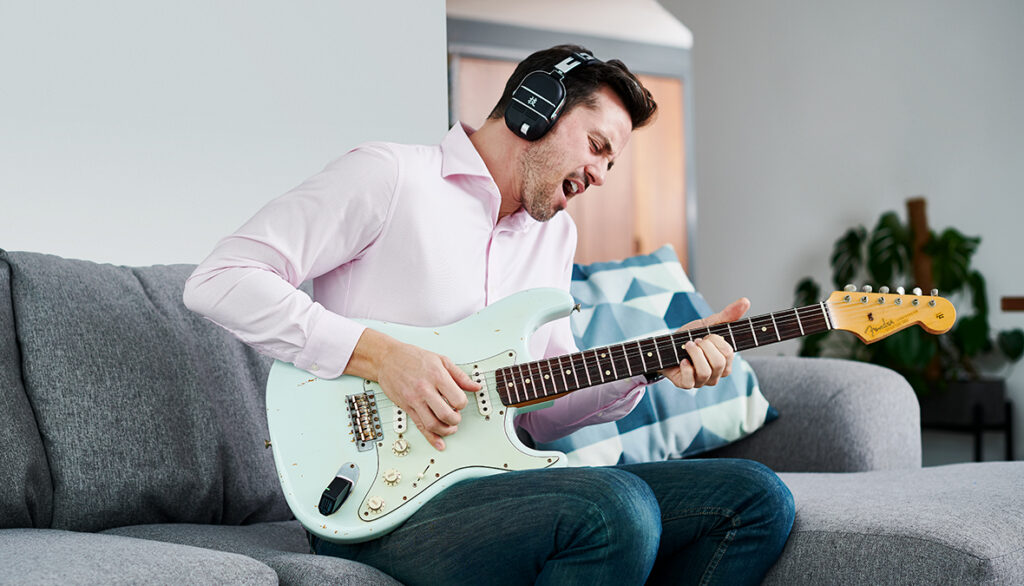
No wires, No Hassle! Traditional wireless headphones, like Bluetooth ones, always had a delay from the time you play to the time you hear the sound, making them impractical. This might be the first product in history that allows guitarists to hear their play without any delay. It is very comfortable to listen to the guitar playing in headphones without all cables.
Pro 2: High-Quality Amp and Effects
Similar to the KATANA amp, it offers a range of amp modeling from clean to drive to high-gain, along with several effects like delay/reverb and popular modulation effects. It’s more than enough for regular guitar practice. Those who want more effects should connect their dedicated pedalboards to a traditional amp. Although many test it with electric guitars, it also has a mode for bass.
| Category | Effect Name | Description |
|---|---|---|
| AMP TYPE | BROWN | BOSS’s WAZA Brown, focused on sharp lead sound. |
| AMP TYPE | LEAD | Gain setting allows for a wide range from crunch to high gain. |
| AMP TYPE | CRUNCH | Fat crunch sound that responds faithfully to picking nuances. |
| AMP TYPE | CLEAN | A clean and natural sound. Suitable for solos and leads when combined with BOOSTER. |
| AMP TYPE | FLAT/BASS/ACOUSTIC | Supports electronic instruments, bass, and acoustic guitar connections. |
| CABINET RESONANCE | VINTAGE | Warm and sweet sound of a vintage cabinet. |
| CABINET RESONANCE | MODERN | Modern cabinet sound with a tight low end. |
| CABINET RESONANCE | DEEP | Sound with powerful low end and prominent edges. |
| BST (BOOSTER) | CLEAN BOOST | Provides a punchy clean tone and can be used as a booster. |
| BST (BOOSTER) | TREBLE BOOST | A booster with bright characteristics. |
| BST (BOOSTER) | MID BOOST | Booster with a focus on the midrange. |
| BST (BOOSTER) | CRUNCH OD | Crunch sound with added amp distortion elements. |
| BST (BOOSTER) | BLUES DRIVE | BOSS BD-2 style crunch sound. |
| BST (BOOSTER) | OVERDRIVE | Modeled after the BOSS OD-1 sound. |
| BST (BOOSTER) | NATURAL OD | Natural overdrive sound. |
| BST (BOOSTER) | WARM OD | Warm overdrive. |
| BST (BOOSTER) | TURBO OD | High-gain overdrive, reminiscent of BOSS OD-2. |
| BST (BOOSTER) | T-SCREAM | Modeled after the Ibanez TS-808 sound. |
| BST (BOOSTER) | DISTORTION | Classic distortion sound. |
| BST (BOOSTER) | FAT DS | Distortion sound with a thick tone. |
| BST (BOOSTER) | DST+ | Modeled after the MXR DISTORTION+ sound. |
| BST (BOOSTER) | GUV DS | Modeled after the Marshall GUV’NOR sound. |
| BST (BOOSTER) | RAT | Modeled after the Proco RAT sound. |
| BST (BOOSTER) | METAL ZONE | Modeled after the BOSS MT-2 sound. |
| BST (BOOSTER) | METAL DS | Ideal distortion sound for heavy riffs. |
| BST (BOOSTER) | ’60S FUZZ | Modeled after the FUZZFACE sound. |
| BST (BOOSTER) | MUFF FUZZ | Modeled after the Electro-Harmonix Big Muff π sound. |
| BST (BOOSTER) | OCT FUZZ | Fuzz sound with rich harmonic content. |
| MOD / FX | CHORUS | Natural chorus sound is achieved by providing two types of chorus for low and high frequencies. |
| MOD / FX | FLANGER | Creates a flanging effect, giving the sound a jet-like undulation. |
| MOD / FX | PHASER | Adds a rotating sensation to the sound by adding a phase-shifted sound to the direct sound. |
| MOD / FX | UNI-V | Modeled after the Uni-vibe. Similar to a phaser but with a unique undulation. |
| MOD / FX | TREMOLO | Effect that periodically changes the volume. |
| MOD / FX | VIBRATO | Creates a vibrato effect by subtly shaking the pitch. |
| MOD / FX | ROTARY | Effect that simulates a rotating speaker. |
| MOD / FX | RING MOD | Changes the sound to a metallic resonance without a sense of pitch. |
| MOD / FX | SLOW GEAR | Creates a volume technique (violin technique) effect. |
| MOD / FX | SLICER | Creates an effect that sounds like playing a backing phrase by continuously slicing the sound. |
| MOD / FX | COMP | Effect that achieves long sustain by equalizing the input signal volume. |
| MOD / FX | LIMITER | Prevents distortion by suppressing large inputs. |
| MOD / FX | T. WAH | Achieves a wah effect by changing the filter according to the guitar volume. |
| MOD / FX | AUTO WAH | Achieves an automatic wah effect by periodically changing the filter. |
| MOD / FX | PEDAL WAH | Achieves a pedal wah effect. |
| MOD / FX | GRAPHIC EQ | Adjusts the sound quality. Can adjust 10 bands. |
| MOD / FX | PARAMETRIC EQ | Adjusts the sound quality. Can adjust 4 bands. |
| MOD / FX | GUITAR SIM | Simulates characteristics of a guitar, such as pickups and body. |
| MOD / FX | AC.GUITAR SIM | Changes the electric guitar sound to an acoustic guitar sound. |
| MOD / FX | AC. PROCESSOR | Changes the output sound of pickups, such as electric acoustic guitars, to a rich sound as if it was recorded with a microphone. |
| MOD / FX | WAVE SYNTH | Processes the guitar input sound to produce a synth sound. |
| MOD / FX | OCTAVE | Adds a sound one octave below the input to create a sense of weight in the bass. |
| MOD / FX | PITCH SHIFTER | Effect that can change the pitch by ±2 octaves. |
| MOD / FX | HARMONIST | Adjusts the pitch shift amount by analyzing the pitch of the input guitar to create a harmony on the diatonic scale. |
| MOD / FX | HUMANIZER | Changes the guitar sound to sound like a human voice. |
| MOD / FX | PHASER 90E | Modeled after the MXR EVH-90 Phase Shifter sound. |
| MOD / FX | FLANGER117E | Modeled after the MXR EVH-117 Flanger sound. |
| DELAY / DELAY 2 | DIGITAL | Simple delay. |
| DELAY / DELAY 2 | ANALOG | Achieves a mild sound of an analog delay. |
| DELAY / DELAY 2 | TAPE ECHO | Achieves the fluctuating sound unique to tape echo. |
| DELAY / DELAY 2 | REVERSE | Creates a reverse playback effect. |
| DELAY / DELAY 2 | MODULATE | Delay with a pleasant fluctuation added. |
| DELAY / DELAY 2 | SDE-3000 | Modeled after the Roland SDE-3000 sound. |
| REVERB | PLATE | Simulates plate reverb (reverb unit using the vibration of a metal plate). Achieves a metallic resonance with extended high frequencies. |
| REVERB | ROOM | Simulates the reverberation sound in a room. Achieves a warm reverberation sound. |
| REVERB | HALL | Simulates the reverberation sound in a concert hall. Achieves a clear reverberation sound with a sense of spread. |
| REVERB | SPRING | Simulates the spring reverb built into a guitar amp. |
| REVERB | MODULATE | Reverb with fluctuation added to the hall’s reverberation, achieving a very pleasant reverberation sound. |
| EQ (PARAMETRIC EQ) | EQ (PARAMETRIC EQ) | Adjusts the sound quality. Can adjust 4 bands. |
| NS | NS | Effect that suppresses noise and hum picked up by the guitar pickup. Achieves a natural effect with minimal impact on the guitar sound. |
Sound Review
Given the nature of headphones, it’s challenging to showcase sound samples. However, Andertons did it! The sample starts around 11:26 in their video. Listening to this video with headphones or earphones gives an almost identical experience to try it out in person. The distorted sound has that BOSS feel, and it’s genuinely good.
Pro 3: Audio Playback and Sound Creation via Bluetooth App
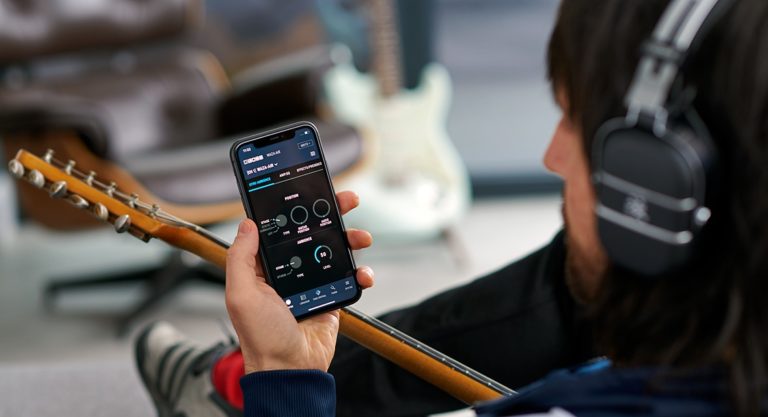
By connecting a smart device via Bluetooth, you can play along with tracks stored on the device. This is especially useful with the numerous backing tracks available on YouTube. Additionally, by installing the dedicated app BOSS TONE CENTRAL (search for BTS for WAZA-AIR) on iOS or Android, you can adjust the amp and effects settings on your device. The app also offers presets for various genres like Blues, Jazz, Rock, Metal, Soul, Reggae, and more. It even has a tuner mode, providing all the functionalities you need for home play.
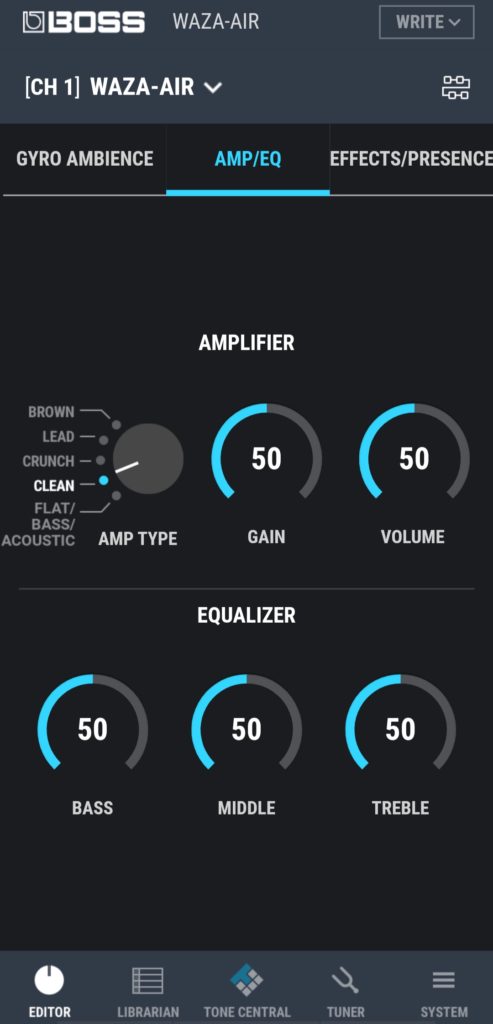
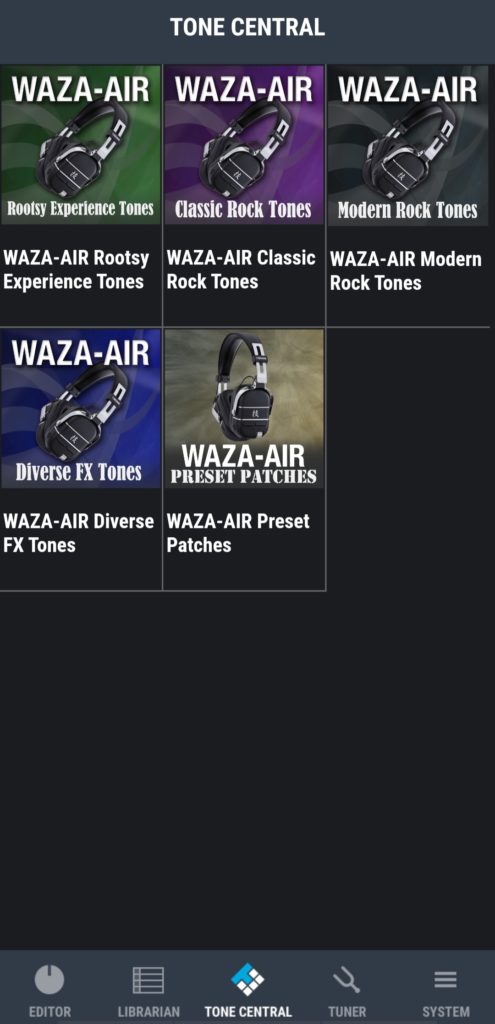
Pro 4: Selectable Playing Environment with Gyro Sensor
It gives you the feeling of playing an amp in a studio or on stage. For instance, if you turn to the right, the guitar sound in your left ear becomes more prominent. Playing with live tracks in STAGE mode makes it feel like the sound is coming from behind, which is quite exhilarating.
Pro 5: Easy Operation with Just the Main Unit (Volume/Patch)
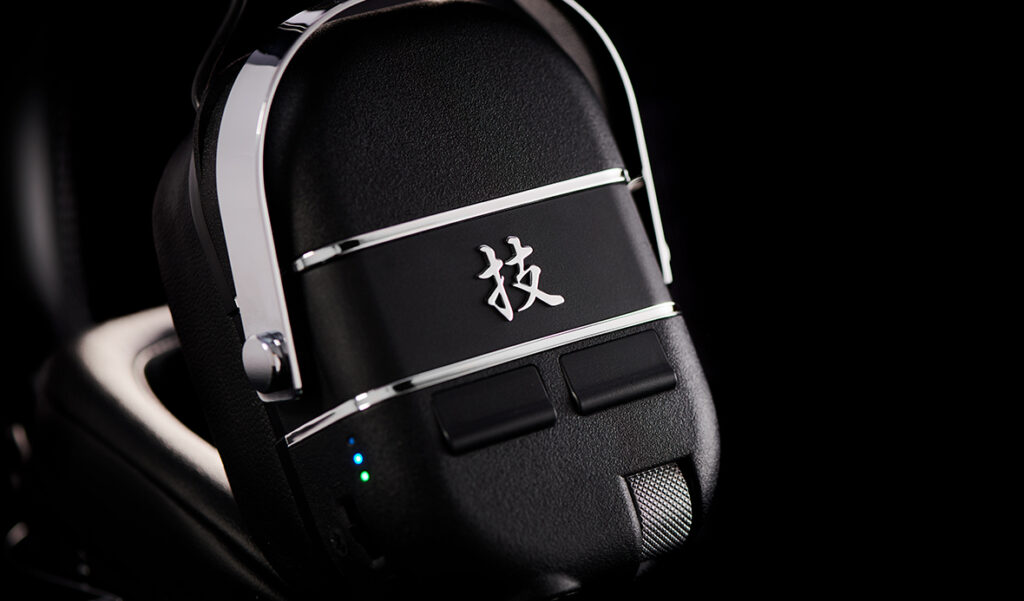
It’s convenient not to have to open the app every time you want to play a bit. The NUX Mighty-Air seems cumbersome in this regard. The main volume is a wheel, making it easy to adjust while wearing the headphones. The volume changes are subtle, allowing for fine-tuning. Additionally, you can switch patches using the main unit button. These small features significantly enhance the guitar-playing experience.
Pro 6: Excellent Hold of the Headphones
The headphones have a stronghold, which I personally find very satisfactory. However, they can become slightly uncomfortable after 90 minutes when I wear glasses. WAZA-AIR will fly off if you headbang, so it’s not recommended for that kind of practice. lol
Pro 7: Compact Storage
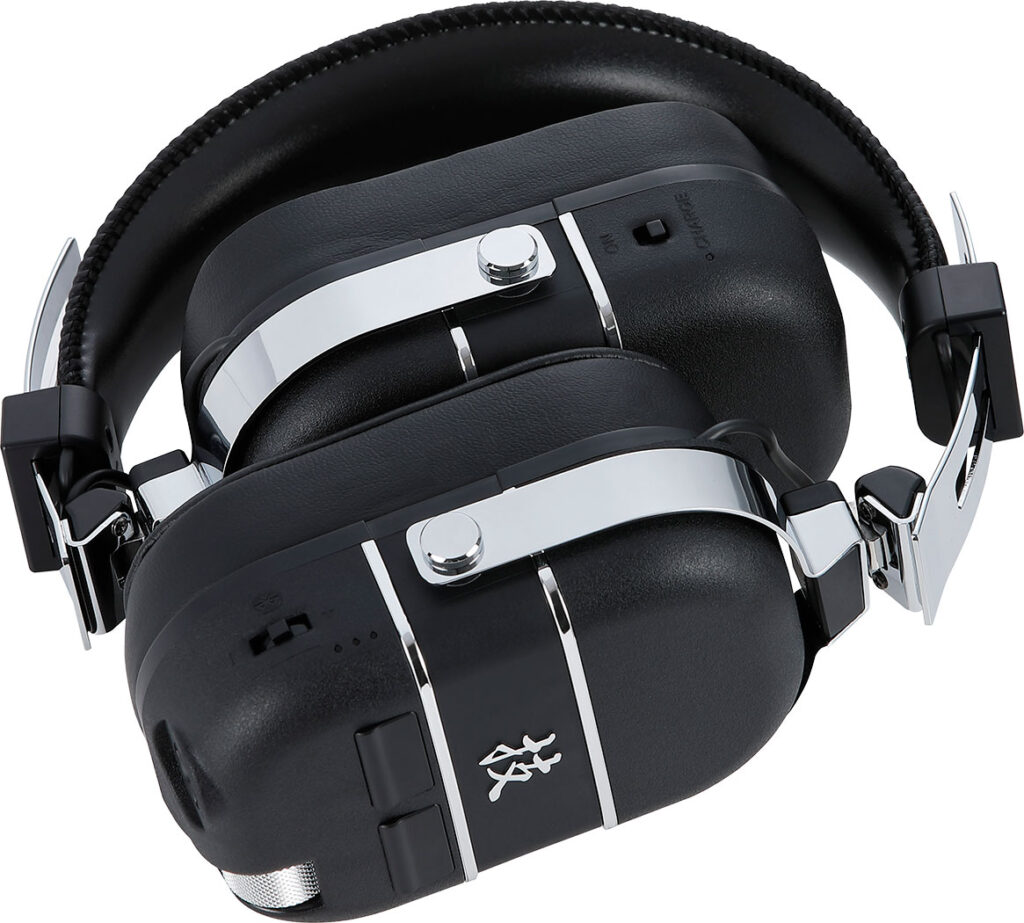
Unlike amps, its compact size doesn’t take up much space. A headphone stand is handy for storage. The Hercules HA700, which can be attached to a guitar stand, is recommended.
Cons of BOSS WAZA-AIR
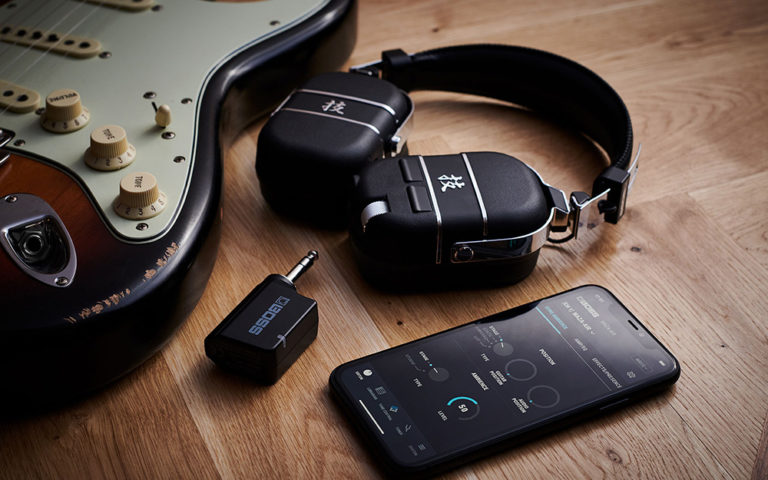
- Sound Quality
- No Need Gyro Sensor for me
- Occasional Connection Interruptions
- Charging Two Devices is Cumbersome
- Weak Tracking of the Pitch Shifter
Con 1: Sound Quality
It’s not necessarily bad, but it has the typical BOSS sound. The high-gain distortion has a certain graininess, which I personally wish was a bit smoother. However, it’s acceptable for practice.
Con 2: No Need Gyro Sensor for me
While there were pre-release videos of famous guitarists being amazed by this feature, I found it unnecessary. When practicing carefully, moving my head to look at my left hand’s fingering or my right hand’s picking activates the gyro sensor, changing the sound field, which can be annoying. I’ve kept it off since the first day.
Con 3: Occasional Connection Interruptions
I’m not sure if it’s just my unit or the Wi-Fi environment at home, but sometimes the green LED indicating the transmitter’s connection stays on, but there’s no guitar sound. Bluetooth audio continues to play. Unplugging and plugging the guitar back in usually fixes it.
Con 4: Charging Two Devices is Cumbersome
Both the headphones and the wireless transmitter need separate charging. However, both have decent battery life, so it hasn’t been a significant issue.
Con 5: Weak Tracking of the Pitch Shifter
While it’s not its primary function, the pitch shifter can simulate down-tuning. However, the sound quality deteriorates slightly. The Line6 HX Stomp offers better quality for this purpose.
BOSS WAZA-AIR Overall Impressions
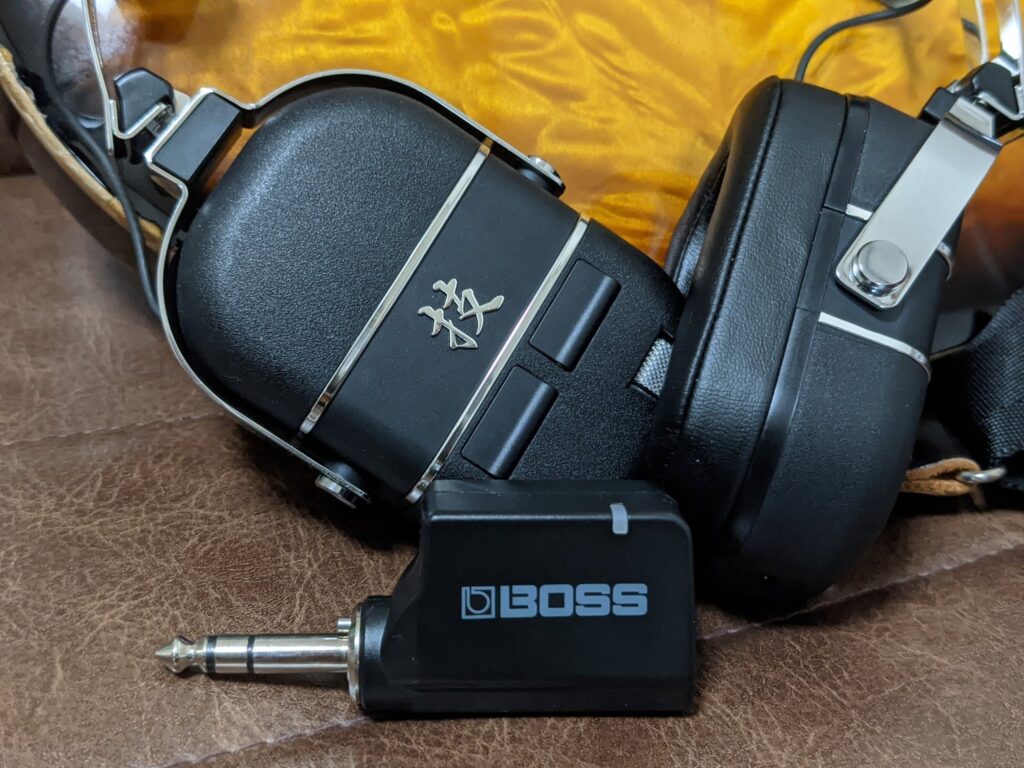
Personally, I believe WAZA-AIR is the best home practice tool. It allows you to play at volumes that would be impossible in typical households, especially in apartments. While wired headphones can achieve this, immersion is crucial for focused practice. The absence of cords in wireless headphones significantly enhances this immersion.
Practicing at a sufficient volume has numerous benefits:
- It makes you more aware of muting unnecessary strings.
- It improves your right-hand control and dynamics. On the flip side, practicing at low volumes can lead to poor outcomes when you play through a loud amp in a studio.
Nowaday, I use WAZA-AIR and Spark MINI. When I can not sound loud volume at home, I use WAZA-AIR. Practicing guitar with wireless headphones is perfect for home practice every time, and I’ve been playing the guitar more, which is great. I recommend this gear.

